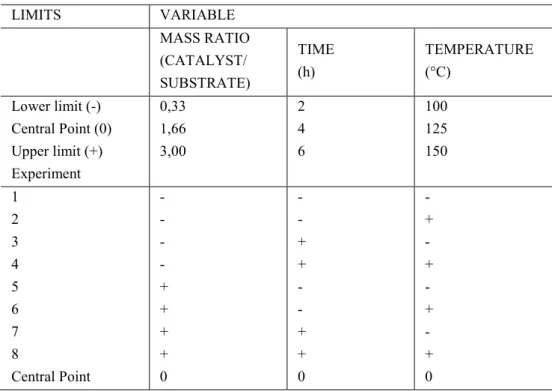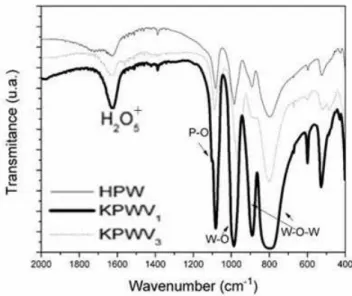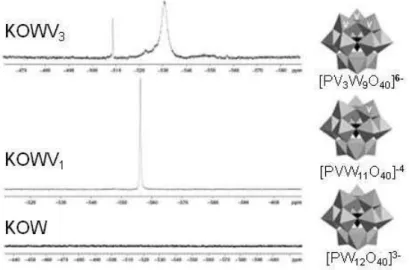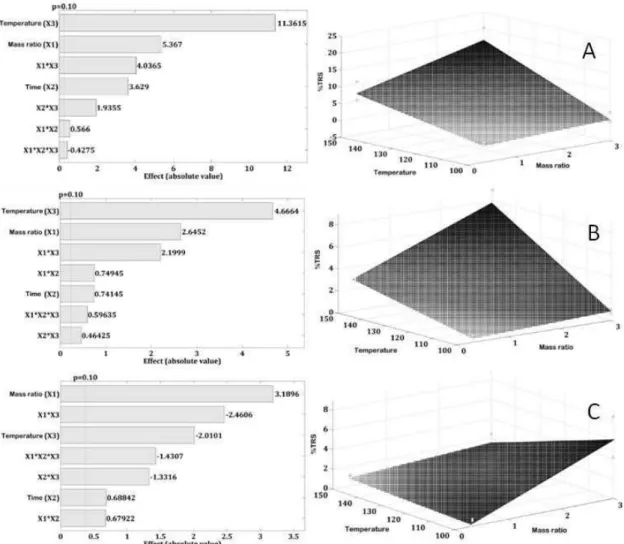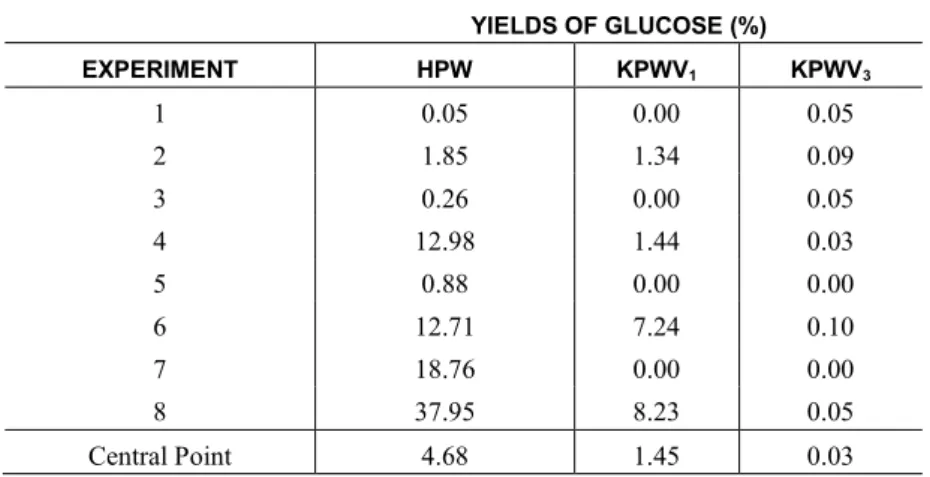ISSN 1517-7076 artigo e11866, 2017
Autor Responsável: Ana Carolina Cunha Arantes Data de envio: 26/08/2016 Data de aceite: 31/05/2017
10.1590/S1517-707620170003.0200
Hydrolysis of cellulose using heteropoly
salts derivatives from H
3PW
12O
40with
different redox properties as catalysts
Ana Carolina Cunha Arantes1, Anna Cláudia Santos de Oliveira1, Willian Miguel da Silva Borges1, Maria Lucia Bianchi1, Eliane Cristina de Resende2
1 Federal University of Lavras, Department of Chemistry, P.O. Box 3037, 37200-000, Lavras, MG, Brazil e-mail:
anacar-olinacarantes@gmail.com, annaclaudia_sam@hotmail.com ,will_msb@hotmail.com, bianchi@dqi.ufla.br
2
Department of Science and Language, Federal Institute of Minas Gerais, 38900-000, Bambuí, MG, Brazil e-mail: eli-ane.resende@ifmg.edu.br
ABSTRACT
Heteropoly salts containing different numbers of vanadium atoms (K4[PVW11O40] - KPWV1 and K6[PV3W9O40] - KPWV3) were synthesized from the heteropoly acid H3PW12O40 (HPW), and used as cata-lysts in hydrolysis of cellulose reactions in order to change the redox properties and verify whether the clus-ter of catalysts are involved in mechanism reaction. The hydrolysis reactions following a full 23 factorial design with the variables: mass ratio (catalyst/substrate), reaction time and temperature. The variables evalu-ated were significant at a 90% confidence level including second and third order interactions. According to the conducted experiments, the catalysts were all active in hydrolysis. The best results occurred when HPW was used suggesting that the redox properties did not have much influence in depolymerization of cellulose and the hydrolysis mechanism are assigned to acidic properties of the medium. The main products obtained from the reactions were glucose and HMF, which are products of great interest in the chemical industry. Keywords: hydroxymethylfurfural, redox properties, tungstophosphoric acid.
1. INTRODUTION
Heteropoly acids (HPAs) are used as catalysts in a wide variety of chemical reactions [1, 2, 3, 4]. They are included in a class of polyoxometalates which are defined as ionic clusters, with general formula [MmOy]p- or [XxMmOy]q-, where M is a transition metal (generally V, Mo or W), and X is a heteroatom (typically Si, B or P). When the counter ions of heteropoly anions are protons, they are called HPAs [5].
The HPAs have acidic and redox catalytic properties, are thermally stable, and show high solubility in water and organic solvents. These properties are dependent upon the metal and are not influenced substantial-ly by the heteroatom. The most important HPAs in catasubstantial-lysis are the Keggin structure; among them, tung-stophosphoric acid (HPW) is widely used [6].
The primary structure of polyoxometalates is a polyanion, a cluster with a central tetrahedron (XO4) surrounded by twelve octahedra (MO6). The secondary structure concerns the three-dimensional arrangement of the polyanion and counter ions. The tertiary structure represents how the secondary structure is grouped into solid particles and is responsible for pore volume, surface area, particle size and dispersion. Related to these factors, the tertiary structure exerts the largest influence on the catalytic activity of HPAs [7].
The HPAs can be used as catalysts in acid hydrolysis of cellulose [8, 9, 10, 11]. Cellulose is a major component of biomass, a renewable raw material for the production of ethanol and numerous additional chemical products [12]. The cellulose extracted from biomass is composed of D-glucose units linked by gly-cosidic bonds that when hydrolyzed, can release monomers of glucose, which are fermentable to produce ethanol [13]. First or second generation bioethanol can be used as a substitute for gasoline (a non-renewable resource) and provides environmental benefits, like less greenhouse gases released into the atmosphere [14].
chem-ical derived from biorefineries [15].
From HMF, several molecules can be produced. These molecules are the result of different catalytic routes when temperature, time, reaction medium, pH, catalysts, etc. are varied [16]. The use of HPAs for the production of HMF has been previously reported. [17, 18, 19]. The reaction mechanism proposed to hydroly-sis of cellulose using HPAs is the same as using mineral acids, starting with protonation of glycosidic oxygen and cleavage of C1-O linkage. The nucleophilic attack of water on C1 with acid regeneration finishes the process. Considering this mechanism, the cluster of HPA does not affect the process. However, a previous work [20] showed that during aerobic oxidation of cellulose in presence of [PMo12-nVnO40](3+n)- heteropoly anions in aqueous medium, the cellulose oxidative depolymerization was mainly associated with redox prop-erties through the action of the VO2+ ions, released from heteropoly anions via partial dissociation under acidic conditions.
In this context, the purpose of this work was evaluate the influence on mechanism of hydrolysis reac-tion. Were verify whether the reaction occurs only by the presence of the hydrogen in the middle, or if mech-anisms redox are involved. For this, modifications have been made in the redox properties of heteropoly salts (synthesized from HPW) replacing W atoms by V atoms [1]. The heteropoly salts synthesized (K4[PVW11O40] (KPWV1) and K6[PV3W9O40] (KPWV3)) they also were characterized and applied as cata-lysts for the cellulose hydrolysis reaction.
2. MATERIALS E METHODS
2.1 Synthesis and characterization of catalysts
HPW (Fluka) was used in reactions and as the synthetic precursor of heteropoly salts. The heteropoly salts, KPWV1 and KPWV3 were synthesized following methodology described by Domaille [20]. For KPWV1, a solutions of HPW and NaVO3 (Vetec) were mixed and the salt was precipitated using KCl (Vetec). For KPWV3, the NaVO3 was added to a buffer solution of acetic acid/sodium acetate, followed by addition of Na8H[PW9O34] (synthesized from methodology described by Massart [21]. The salt was also precipitated by adding KCl. The heteropoly salts were analyzed by FTIR in an IR Affinity equipment using KBr pellets; en-ergy dispersive X-ray (EDS) in a scanning electron microscope (SEM) device coupled with EDS/INCA 350; and a nuclear magnetic resonance (NMR) spectrometer with a 105.19 MHz 51V probe. NMR samples were dissolved in deuterated water (D2O) and filtered before acquisition.
2.2 Hydrolysis reactions
The hydrolysis reactions were performed in a closed system, following a full 23 factorial design with the var-iables: mass ratio (catalyst/substrate), reaction time and temperature. The factorial design, described in Table 1, was analyzed using Chemoface® software (version 1.4) and adjusted according to the experimental condi-tions found. Microcrystalline cellulose (Synth) was used as substrate. The catalysts used were HPW, KPWV1 and KPWV3. The reaction products were analyzed using a Shimadzu UV-1800 UV/Vis spectropho-tometer and the total reducing sugar content (%TRS) was quantified by dinitrosalicylic acid method (DNS) [22] at 540 nm. Analyses by high performance liquid chromatography (HPLC) were conducted on a Shimadzu Prominence chromatograph equipped with a RID-10A detector, a LC-20AT pump and a Shim-pack Amino-
Na column (6 mm × 100 mm; 5 mm particle size) maintained at 80 °C. The isocratic injection used water as mobile phase and an injection volume of 20 µL on a flow of 0.4 mL.min-1. In both analyses, glucose (Merck) was used as a reference standard. In order to identify additional products, the reaction mixtures were analyzed utilizing mass spectrometry with electrospray ionization (Agilent-1100 ESI-MS). The products were analyzed by direct infusion with a flow injection 15 μL min-1
Table 1: Full factorial experimental design of hydrolysis reactions.
LIMITS VARIABLE
MASS RATIO (CATALYST/ SUBSTRATE)
TIME (h)
TEMPERATURE (°C)
Lower limit (-) 0,33 2 100
Central Point (0) 1,66 4 125
Upper limit (+) 3,00 6 150
Experiment
1 - - -
2 - - +
3 - + -
4 - + +
5 + - -
6 + - +
7 + + -
8 + + +
Central Point 0 0 0
3. RESULTS AND DISCUSSION
3.1 Synthesis and characterization of catalysts
Figure 1: FTIR spectra of catalysts - HPW, KPWV1 and KPWV3.
EDS is a semi-quantitative analysis of elements present on the sample surface and identification oc-curs through specific energy emissions of each element. An area was delimited from the scanning electron microscopy (SEM) images generated and the elements within this area were quantified by EDS. In the analy-sis of HPW (Figure 2a), the main elements present are phosphorus, tungsten and oxygen. For KPWV1 (Fig-ure 2b) and KPWV3 (Figure 2c), the incorporation of vanadium can be observed in each spectrum, with the data for KPWV3 demonstrating a larger quantity of vanadium. In addition, potassium and chlorine remaining from the synthesis [21] and elements from the HPW precursor are also present.
Figure 2: EDS spectrum of catalysts a) HPW, b) KPWV1 and c) KPWV3
Figura 3: 51V NMR spectra and possible positions of the V atoms (adapted from Mizuno and Kamata, 2011) in the structures of catalysts - HPW, KPWV1 and KPWV3
3.2 Hydrolysis reactions
The cellulose hydrolysis reactions followed the experimental design shown in Table 1. The factorial design allows for evaluation of several variables in a reduced number of experiments. The variables and levels de-fined in a factorial design depend on the system and the reaction medium [26]. The variables evaluated (mass ratio catalyst/substrate, reaction time and temperature) were significant at a 90% confidence level and includ-ed second and third order interactions, as shown in Pareto's chart (Figure 4a) using cellulose as the substrate and HPW as the catalyst.
In a first order analysis, the temperature has greater influence than the mass ratio and the time on %TRS results. The second and third order interactions are significant, however, less so than temperature and mass ratio. Since the time variable has smaller influence on the results, the response surface (Figure 4a) was plotted considering the time at level 0 (4 hours) and showing mass ratio, %TRS and temperature on the X, Y and Z axes, respectively.
The response surface demonstrates that the best reaction results occur at maximum levels of factorial design; in other words, when the temperature and amount of catalyst used is high, the conversion of %TRS is also high. In a second analysis, longer time periods were also shown to promote higher conversion. This trend is also observed when using KPWV1 as the catalyst, and can be observed in Pareto's chart and in the response surface (Figure 4b).
Figura 4: Pareto's chart and response surface from factorial design of hydrolysis reactions using cellulose as substrate and a) HPW, b) KPWV1, c) KPWV3 as catalyst. The reactions were performed in a closed system, following a full
facto-rial design 23, analyzed using Chemoface®, with confidence level 90% and the varia-bles: mass ratio (catalyst/substrate) (lower limit 0.33 and upper limit 3.00), reaction time (lower limit 2h and upper limit 6h) and temperature (lower limit 100 °C and upper limit 150 °C).
The decrease in %TRS conversion can be explained by the acidity of the catalysts, where the HPW was the most acidic of those used [1]. This was confirmed by measuring the pH of the reaction media; the HPW medium was found to be pH 2.5, while KPWV1 was pH 3.7, and KPWV3 was pH 7.2. Replacing W atoms with V atoms in the structure was intended to change the redox properties of the heteropoly anion and verify whether the mechanism of the hydrolysis reaction occurs only by the presence of the hydrogen in the middle, or if there was some characteristic of the heteropoly anion involved. Due to the significant decrease in acidity, were performed additional reactions using the acids of the heteropoly salts HPWV1 (H4[PVW11O40]) and HPWV3 (H6[PV3W9O40]) at central point conditions.
At the same pH (2.5), it is clear that acidity of the medium is the main factor in hydrolysis of cellulose comparing the results in %TRS reactions using HPW (4.1%), HPWV1 (2.2%) and HPWV3 (1.1%). Although a redox reaction occur promoted by VO2+ ions, observed in color changes, the depolymerization cannot be associated with that, because these reactions require an oxidizing reactant to continuous the cycle, like O2 or H2O2 [20].
Table 2: Glucose yields using factorial design and different catalysts
YIELDS OF GLUCOSE (%)
EXPERIMENT HPW KPWV1 KPWV3
1 0.05 0.00 0.05
2 1.85 1.34 0.09
3 0.26 0.00 0.05
4 12.98 1.44 0.03
5 0.88 0.00 0.00
6 12.71 7.24 0.10
7 18.76 0.00 0.00
8 37.95 8.23 0.05
Central Point 4.68 1.45 0.03
Low conversion to glucose can be observed, particularly when using heteropoly salts. However, in addition to glucose, there was formation of another compound in larger quantities; this compound was identi-fied, by mass spectrometry, as HMF, an important molecule in chemistry industry. The analysis was per-formed on the products of the hydrolysis reaction corresponding to the central point of the factorial design using HPW as the catalyst.
Among the peaks, could be observed the presence of the signal corresponding to HMF at m/z = 127. This compound was isolated and the fragments at m/z = 98 and 108, could be observed in the MS/MS spec-trum, relates to loss of CO and loss of water, respectively. According to the above analyses, HPW, KPWV1 and KPWV3 present themselves as good catalysts for the production of HMF, precursor of several different molecules.
4. CONCLUSION
The heteropoly salts were synthesized from HPW and the characterizations showed the effectiveness of the synthesis. The catalysts were all active for the production of glucose and HMF. Although the hydrolysis oc-curred when the heteropoly salts were used, a large decrease in %TRS conversion was observed (compared to HPW); this was a result of the difference in acidity between the catalysts, showing that cluster of HPA is not involved in reaction mechanism.
5. ACKNOWLEDGEMENTS
The authors gratefully acknowledge CAPES (Coordenação de Aperfeiçoamento de Pessoal de Nível Superi-or) and FAPEMIG (Fundação de Amparo à Pesquisa do Estado de Minas Gerais) for the financial support and CAPQ (Central de Análises e Prospecção Química) – UFLA (Universidade Federal de Lavras) for tech-nical support.
6. BIBLIOGRAPHY
[1] TIMOFEEVA, M. N., “Acid catalysis by heteropoly acids”, Applied Catalysis A: General, v. 256, no 1–2.
pp. 19–35, Dec. 2003.
[2] KOZHEVNIKOV, I. V., “Sustainable heterogeneous acid catalysis by heteropoly acids”, Journal of Mo-lecular Catalysis A: Chemical, v. 262, no 1–2, pp. 86–92, fev. 2007.
[3] GUO, F., FANG, Z., XU, C. C, E SMITH, R. L. et “Solid acid mediated hydrolysis of biomass for pro-ducing biofuels”, Progress in Energy and Combustion Science., v. 38, no 5, pp. 672–690, out. 2012.
[4] GROMOV, N. V., TARAN, O. P., DELIDOVICH, I. V., et al., “Hydrolytic oxidation of cellulose to formic acid in the presence of Mo-V-P heteropoly acid catalysts”, Catalysis Today., Available online 31 Mar 2016.
[5] POPE, M. T., Heteropoly and Isopoly Oxometalates, 1ª ed. Berlin, Springer, 1983.
[6] KOZHEVNIKOV, I. V., “Catalysis by Heteropoly Acids and Multicomponent Polyoxometalates in Liq-uid-Phase Reactions.”, Chemical Reviews, v. 98, no 1, pp. 171–198, fev. 1998.
[7] MIZUNO, N., MISONO, M., “Heterogeneous Catalysis.”, Chemical Reviews, v. 98, n. 1, pp. 199–218,
[8] TIAN, J., WANG, J., ZHAO, S., et al., “Hydrolysis of cellulose by the heteropoly acid H3PW12O40”,
Cel-lulose, v. 17, n. 3, pp. 587–594, jan. 2010.
[9] CHENG, M., SHI, T., GUAN, H., et al., “Clean production of glucose from polysaccharides using a
mi-cellar heteropolyacid as a heterogeneous catalyst”, Applied Catalysis B Environmental, v. 107, n. 1–2, pp.
104–109, ago. 2011.
[10] CHAMBON, F., RATABOUL, F., PINEL, C., et al., “Cellulose hydrothermal conversion promoted by
heterogeneous Brønsted and Lewis acids: Remarkable efficiency of solid Lewis acids to produce lactic acid”,
Applied Catalysis. B Environmental, v. 105, n. 1–2, pp. 171–181, jun. 2011.
[11] YABUSHITA, M., KOBAYASHI, H. AND FUKUOKA, A. “Catalytic transformation of cellulose into platform chemicals”, Applied Catalysis. B Environmental, v. 145, pp. 1–9, fev. 2014.
[12] SRIRANGAN, K., AKAWI, L., MOO-YOUNG, M., AND CHOU, C. P., “Towards sustainable produ c-tion of clean energy carriers from biomass resources”, Applied Energy, v. 100, pp. 172–186, jun. 2012.
[13] FENGEL, D. AND WEGENER, G., Wood: chemistry, ultrastructure, reactions. Berlin, Walter de Gruyter, 1984.
[14] SARKAR, N., GHOSH, S. K., BANNERJEE, S., et al., “Bioethanol production from agricultural wastes: An overview”, Renewable Energy, v. 37, pp. 19–27, jul. 2011.
[15] BOZELL J. J. AND PETERSEN, G. R., “Technology development for the production of biobased products from biorefinery carbohydrates — the US Department of Energy’s ‘Top 10’ revisited”, Green Chemistry, v. 12, n. 4, pp. 539–554, Mar. 2010.
[16] WETTSTEIN, S. G., ALONSO, D. M., GÜRBÜZ, E. I., et al., “A roadmap for conversion of lignoce l-lulosic biomass to chemicals and fuels”, Current Opinion in Chemical Engineering, v. 1, n. 3, pp. 218–224, ago. 2012.
[17] ZHAO, Q., WANG, L., ZHAO, S., et al., “High selective production of 5-hydroymethylfurfural from fructose by a solid heteropolyacid catalyst”, Fuel, v. 90, n. 6, pp. 2289–2293, jun. 2011.
[18] LANZAFAME, P., TEMI, D. M., PERATHONER, S., et al., “Direct conversion of cellulose to glucose
and valuable intermediates in mild reaction conditions over solid acid catalysts”, Catalysis Today, vol. 179, no 1, pp. 178–184, Jan. 2012.
[19] WANG, H., DENG, T., WANG, Y., et al., “Efficient catalytic system for the conversion of fructose into 5-ethoxymethylfurfural.”, Bioresource Technology, v. 136, pp. 394–400, may 2013.
[20] SHATALOV, A., EVTUGUIN, D. AND PASCOAL NETO, C., “Cellulose degradation in the reaction system O2/heteropolyanions of series [PMo(12-n)VnO40](3+n)-”, Carbohydrate Polymers, v. 43, n. 1, pp. 23–32, set. 2000.
[21] DOMAILLE, P. J. “1 - and 2-Dimensional Tungsten- 183 and Vanadium-51 NMR Characterization of Isopolymetalates and Heteropolymetalates”, Journal of American Chemical Society, v. 106, n. 25, pp. 7677–
7687, Dec. 1984.
[22] MASSART, R., CONTANT, R., FRUCHART, J.-M., et al.,“ Phosphorus-31 NMR Studies on Molybdic
and Tungstic Heteropolyanions. Correlation between Structure and Chemical Shift”, Inorganic Chemistry, v. 16, n. 11, pp. 2916–2921, Nov. 1977.
[23] MILLER, G. L. “Use of Dinitrosalicylic Acid Reagent for Determination of Reducing Sugar”, Analyti-cal Chemistry, v. 31, n. 3, pp. 426–428, Mar. 1959.
[24] DIAS, J. A., CALIMAN, E., DIAS, S. C. L., “Effects of cesium ion exchange on acidity of 12 -tungstophosphoric acid”, Microporous mesoporous Mater., v. 76, pp. 221–232, 2004.
[25] MIZUNO, N., AND KAMATA, K., “Catalytic oxidation of hydrocarbons with hydrogen peroxide by vanadium-based polyoxometalates”, Coordination Chemistry Reviews, v. 255, n. 19–20, pp. 2358–2370, Dec.
2011.
